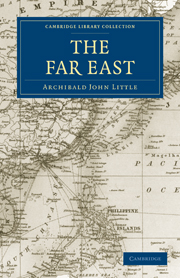Book contents
- Frontmatter
- PREFACE
- EDITORIAL NOTE
- Contents
- LIST OF MAPS AND ILLUSTRATIONS
- CHAPTER I DEFINITION
- CHAPTER II THE CENTRAL KINGDOM: CHINA
- CHAPTER III THE NORTHERN BASIN. THE YELLOW RIVER
- CHAPTER IV THE MIDDLE BASIN: PART I. THE YANGTSE RIVER
- CHAPTER V THE MIDDLE BASIN: PART II. THE PROVINCE OF SZECHUAN
- CHAPTER VI THE MIDDLE BASIN: PART III. THE CHENGTU PLATEAU
- CHAPTER VII THE MIDDLE BASIN: PART IV. THE LOWER YANGTSE PROVINCES
- CHAPTER VIII THE INTERMEDIATE PROVINCES
- CHAPTER IX THE SOUTHERN BASIN. YUNNAN TO CANTON
- CHAPTER X THE DEPENDENCIES: PART I. MANCHURIA
- CHAPTER XI THE DEPENDENCIES: PART II. MONGOLIA
- CHAPTER XII THE DEPENDENCIES: PART III. TURKESTAN
- CHAPTER XIII THE DEPENDENCIES: PART IV. TIBET
- CHAPTER XIV WHILOM DEPENDENCIES: PART I. INDO-CHINA
- CHAPTER XV WHILOM DEPENDENCIES: PART II. COREA
- CHAPTER XVI THE BUFFER KINGDOM: SIAM
- CHAPTER XVII THE ISLAND EMPIRE: JAPAN
- INDEX
- Plate section
CHAPTER XIII - THE DEPENDENCIES: PART IV. TIBET
Published online by Cambridge University Press: 05 October 2010
- Frontmatter
- PREFACE
- EDITORIAL NOTE
- Contents
- LIST OF MAPS AND ILLUSTRATIONS
- CHAPTER I DEFINITION
- CHAPTER II THE CENTRAL KINGDOM: CHINA
- CHAPTER III THE NORTHERN BASIN. THE YELLOW RIVER
- CHAPTER IV THE MIDDLE BASIN: PART I. THE YANGTSE RIVER
- CHAPTER V THE MIDDLE BASIN: PART II. THE PROVINCE OF SZECHUAN
- CHAPTER VI THE MIDDLE BASIN: PART III. THE CHENGTU PLATEAU
- CHAPTER VII THE MIDDLE BASIN: PART IV. THE LOWER YANGTSE PROVINCES
- CHAPTER VIII THE INTERMEDIATE PROVINCES
- CHAPTER IX THE SOUTHERN BASIN. YUNNAN TO CANTON
- CHAPTER X THE DEPENDENCIES: PART I. MANCHURIA
- CHAPTER XI THE DEPENDENCIES: PART II. MONGOLIA
- CHAPTER XII THE DEPENDENCIES: PART III. TURKESTAN
- CHAPTER XIII THE DEPENDENCIES: PART IV. TIBET
- CHAPTER XIV WHILOM DEPENDENCIES: PART I. INDO-CHINA
- CHAPTER XV WHILOM DEPENDENCIES: PART II. COREA
- CHAPTER XVI THE BUFFER KINGDOM: SIAM
- CHAPTER XVII THE ISLAND EMPIRE: JAPAN
- INDEX
- Plate section
Summary
Eurasia, the greatest land mass on the globe, appropriately holds in its centre the loftiest table-land; a table-land walled in by the highest mountains on the earth's surface, rendering it as difficult of access as it is inhospitable to live in. Yet its very inaccessibility has proved a great attraction to travellers, and to-day the character of the country, its chief orographical features, its climate and resources are familiar to all; the blank spaces have been filled in step by step by a series of capable and adventurous travellers, until finally, in 1904, by the members of the mission dispatched by Lord Curzon to Lhasa, under Sir Frank Younghusband, the ‘Forbidden City’ has been once more visited by Europeans and so its mysteries have been unfolded to the outer world.
Tibet occupies an area of some 700,000 square miles, and latest travellers credit it with not more than 800,000 or possibly 1,000,000 inhabitants, making little more than one inhabitant to the square mile; but seeing that six-sevenths of the country is uninhabitable and frequented only during the short summer by nomads on the northern border, who find, in a few of the more favoured spots of the high plateau, a scanty pasture for their flocks and an escape from the great heat and the insect plagues of the lower surrounding depressions, we may relegate some 700,000 inhabitants to the 70,000 square miles of the lower plateau, which should thus be credited with ten inhabitants to the square mile, a figure probably well within the mark.
- Type
- Chapter
- Information
- The Far East , pp. 203 - 218Publisher: Cambridge University PressPrint publication year: 2010First published in: 1905

